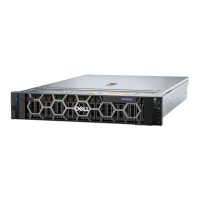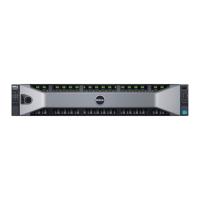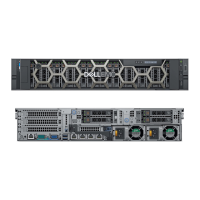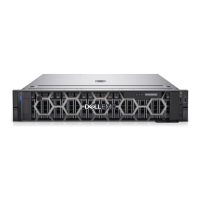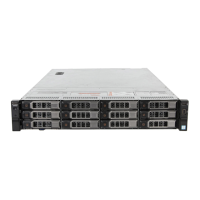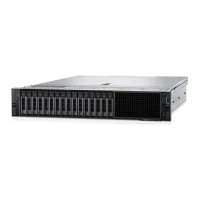Table 72. Memory population rules
Processor Memory population Memory population information
Single processor A{1}, A{2}, A{3}, A{4}, A{5}, A{6},
A{7}, A{8}, A{9}, A{10}, A{11}, A{12},
A{13}, A{14}, A{15}, A{16}
1, 2, 4, 6, 8, 12 or 16 DIMMs are
allowed.
Dual processor (Start with processor1.
Processor 1 and processor 2 population
should match)
A{1}, B{1}, A{2}, B{2}, A{3}, B{3}, A{4},
B{4}, A{5}, B{5}, A{6}, B{6}, A{7},
B{7} A{8}, B{8}, A{9}, B{9}, A{10},
B{10}, A{11}, B{11}, A{12}, B{12}, A{13},
B{13}, A{14}, B{14}, A{15}, B{15},
A{16}, B{16}
2, 4, 8, 12, 16, 24 or 32 DIMMs are
supported per system.
● Populate all the sockets with white release tabs first, followed by the sockets with black release tabs.
● Unbalanced or odd memory configurations result in a performance loss, and the system may not identify the memory
modules being installed. Always populate memory channels identically with equal DIMMs for best performance.
● Supported RDIMM configurations are 1, 2, 4, 6, 8, 12, or 16 DIMMs per processor.
Removing a memory module
Prerequisites
1. Follow the safety guidelines listed in the Safety instructions.
2. Follow the procedure listed in the Before working inside your system.
3. Remove the air shroud.
WARNING:
The memory modules are hot to touch for some time after the system has been powered off. Allow
the memory modules to cool before handling them.
Steps
1. Locate the appropriate memory module socket.
2. To release the memory module from the socket, simultaneously press the ejectors on both ends of the memory module
socket to fully open.
CAUTION:
Handle each memory module only by the card edges, ensuring not to touch the middle of the
memory module or metallic contacts.
3. Lift the memory module away from the system.
Figure 59. Removing a memory module
Installing and removing system components
97

